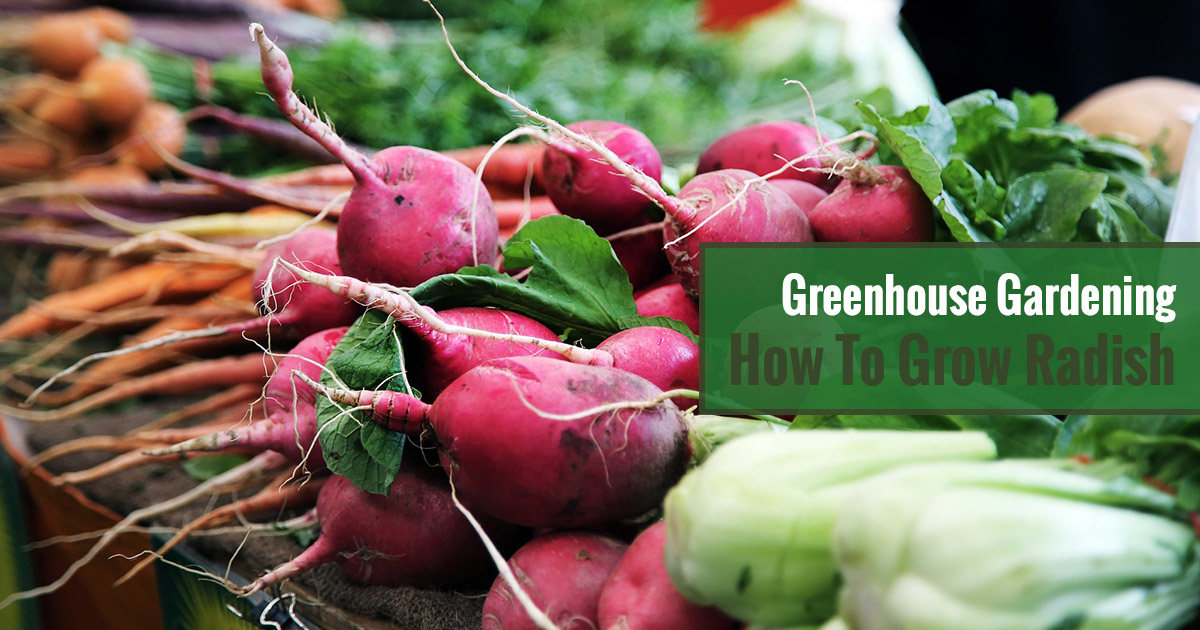



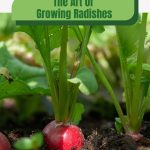





Radishes grow at lightning speed, with many varieties maturing in just a matter of weeks. They are also incredibly easy to grow, making them ideal for beginner gardeners and experienced growers alike. Radishes make for a great crop to grow in your greenhouse all year long, but especially during the winter or shoulder seasons wherever you have a little extra space.
Radishes are a type of root vegetable belonging to the Brassicaceae family (also known as the cabbage family). This crunchy, spicy root makes for a great treat fresh or added to salads and other dishes. Luckily, growing radishes in the greenhouse is easy to do and requires only minimal care.
Are you ready to add radishes to your greenhouse garden? Keep reading to learn all about growing radishes in a greenhouse, from selecting the right variety to having a steady supply of radishes.
Can you grow radishes in a greenhouse?
Radishes are one of the easiest crops to grow in the garden, but does that translate to the greenhouse, too? You’ll be happy to learn that yes, you can grow radishes in a greenhouse for a longer growing season.
Because radishes are a “cool weather” crop, it’s best to grow them during the cooler seasons from fall to spring. In mild climates, you can even grow radishes in a greenhouse or cold frame without a heater in winter. For colder climates, you may have to provide minimal heating.
Grow radishes alongside other cool-weather growing crops such as spinach, lettuce, and leeks. Because they take up very little room and are fast-growing, you can even grow these root vegetables alongside slower-to-germinate crops such as carrots, parsley, and broccoli. By the time the bigger crops start filling out, you’ll be able to harvest your radishes.

Popular radish varieties to grow in a greenhouse
There are many different types of radishes (Raphanus sativus) that you can grow in a greenhouse. While the radishes you might find in the grocery store tend to be small, round, and red, you can get radishes in all shapes, sizes, and color – even black!
When choosing what variety of radishes to grow, appearance isn’t the only thing to consider. Some radishes have a spicy flavor and others are well-suited for heavy soils. If your greenhouse is prone to temperature swings on warm days, bolt-resistant varieties are your best bet.
Here are our top picks for radishes to grow in a greenhouse:

French Breakfast Radish
If you’re looking for a quick-growing, spicy radish, the French Breakfast Radish is a classic choice. French Breakfast Radishes are known for their elongated roots that are pink and white in color.
Days to mature: 26
Watermelon Radish
Watermelon Radishes get their name from their watermelon-like appearance: while the outside is white, the inside is bright pink. The round roots are slightly larger than typical radishes (2-3 inches) and they also store particularly well.
Days to mature: 60
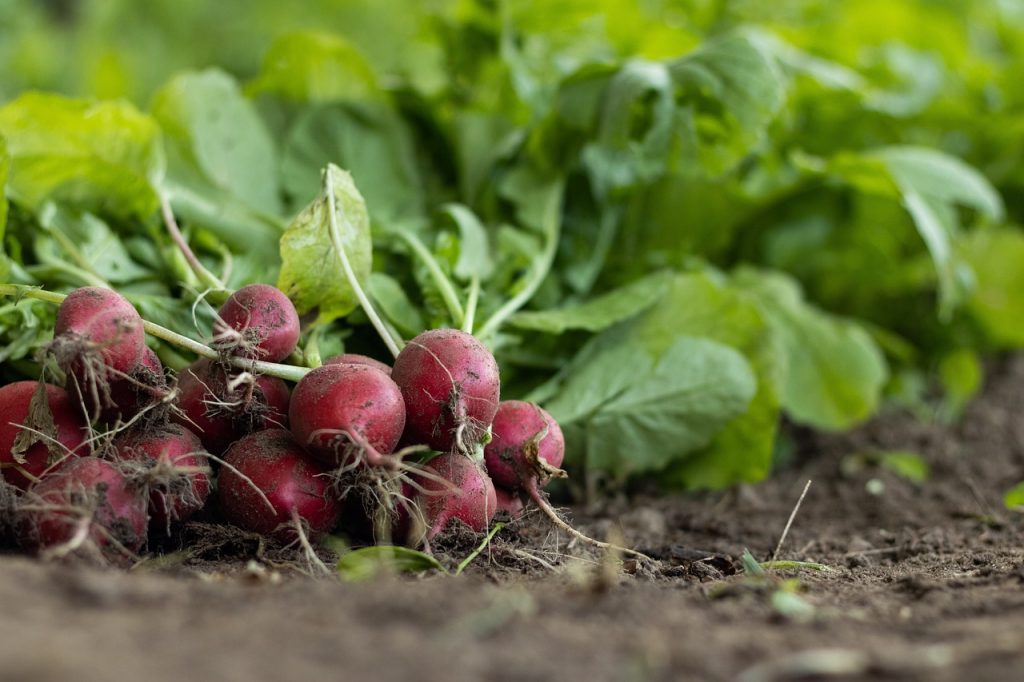
Cherry Belle Radish
Cherry Belle Radishes have the classic radish appearance: round and red with juicy white flesh. They are on the smaller side (typically no bigger than 1 inch), but pack a sharp punch when it comes to flavor. The green tops can also be used fresh or sautéed.
Days to mature: 25
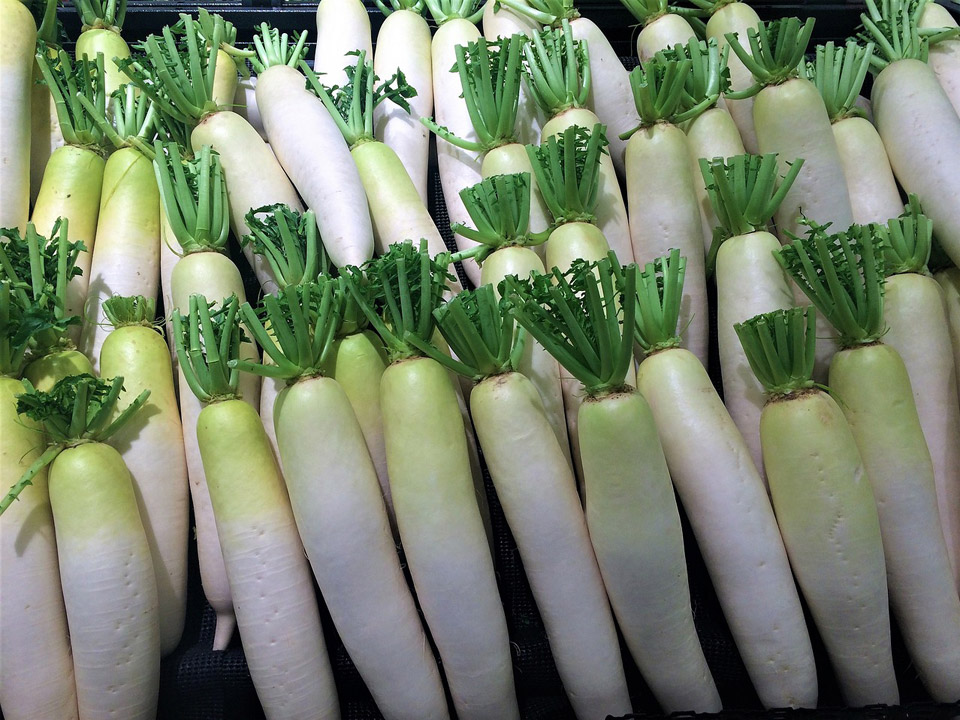
Daikon Radish
Daikon Radishes are a Japanese variety that are much larger than any other radish, growing as long as 12-14 inches and weighing up to 6 pounds! They are particularly well-suited for growing in a greenhouse during the winter. Due to their size, they can penetrate even the heaviest of soils, so you can grow them as a way to naturally break up your soil. Daikon radishes are best enjoyed added to stews or pickled, though they can be sliced and eaten fresh, too.
Days to mature: 50
Quick overview of how to grow radishes in a greenhouse
- Type: Cool-season crop
- Time from seed to harvest: 22-70 days
- Germination temp: 40°F
- Time until first emergence: 7-10 days
- Best temp to grow: 50-70°F
- Height: 6-8 in
- Spread: 4-8 in
- Grow from seed: 1/4-1/2 inches deep, 1-2 inches apart in rows
- Companions: Chervil, marigold, brassicas, dill, parsnip, pole beans, mint, peas, oregano, borage, nasturtiums, rosemary, and eggplant
- Keep away from: Corn, kohlrabi, sunflower, hyssop, turnips, melons, pumpkin, and potatoes
How to plant radishes in a greenhouse
Because radishes grow so fast, and because they are root crops, most people choose to grow them directly from seed. However, you can also sow radishes in seedling trays before transplanting them into the ground. You can even buy radish starts from nurseries, which can be helpful if you’re short on space and/or time.
Depending on your greenhouse size and layout, you can grow radishes in raised beds, directly in the ground, or even in pots. Just make sure to space them appropriately! Daikon radishes are the only variety that we don’t recommend growing in pots due to their size.
Planting radishes from seed
To plant radishes in your greenhouse from seed, start by gathering your supplies. You really only need the seeds and an implement with which to create a trench in the soil. Unlike with heavy-feeding crops such as tomatoes and peppers, you don’t need to add compost or fertilizer to the soil when planting radishes; excessive nitrogen can cause radishes to “leaf out” rather than develop their roots.
Start by creating furrows about 1 inch deep in the soil where you want to grow your radishes. Radishes don’t need much space, so you can do this close to other plants as a filler crop. Sow radish seeds about 1 inch apart and keep rows 8-12 inches apart. For Daikon radishes, sow seeds 4-6 inches apart and keep rows 12-16 inches apart.
Cover the seeds with a thin layer of soil and water gently. Radish seeds are quick to germinate, so you should see seedlings within 5-10 days. Once the seedlings are about a week old, thin radishes to 2 inches apart (or 4-6 inches for Daikon radishes).
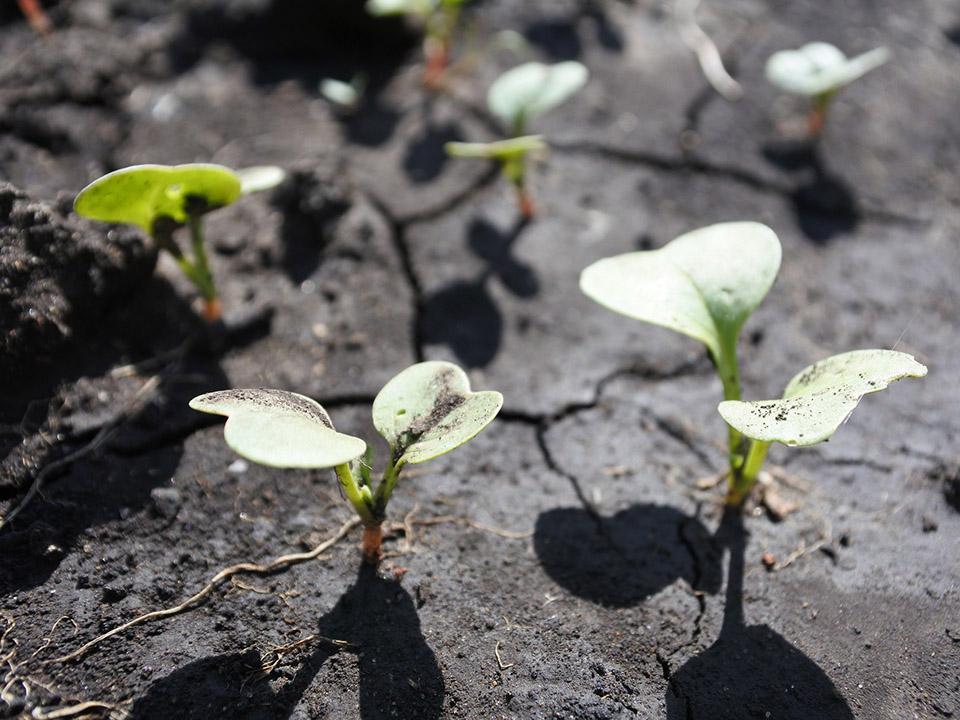
Planting radishes from starts
Growing your own starts or buying them from a nursery allows you to get a head start on growing radishes. This is especially useful if you are waiting to harvest a crop, but want to be ready to plant something in its place as soon as you do.
To grow your own radish starts, sow 2-3 radish seeds per cell in a seedling tray filled with a seed-starting soil mix. Seedling trays tend to dry out quickly, so make sure to keep the soil moist, covering it with a plastic cover to trap in moisture. Once the seedlings are about a week old, or 2-3 inches tall, they are ready to be transplanted into the ground.
Gently remove the radish seedlings from the tray using a transplanting tool or by pinching the bottom. Place the soil cube in the soil, spacing seedlings about 2 inches apart. “Tuck” the seedlings in by gently pressing down on the soil. Water thoroughly.
For radish starts from a nursery, follow the same guidelines. Simply remove the seedlings from the tray and plop them in your greenhouse garden bed or pots, wherever you have space.
Tips for growing radishes in a greenhouse
As a rule of thumb, radishes don’t require much care to grow. However, that doesn’t mean you can forget about them entirely. Like other plants, radishes need water, soil, and light to grow well, especially in a greenhouse.
Watering needs
Radishes require adequate watering, meaning the soil should be consistently moist but not waterlogged. Ideally, ensure your radishes receive about one inch of water per week, which is easily managed with an automatic watering system.
Watering in moderation is key to healthy radishes. If your soil is extremely dry, radishes will bolt before the root has fully developed. If the soil is waterlogged, the roots may decay! You can check the soil by digging down a few inches and feeling for moisture. Alternatively, you can buy a moisture meter to easily keep track for you.
Best soil conditions for radishes
Radishes thrive in loose, well-drained soils that are rich in organic matter. To prevent your radish roots from “branching,” make sure that the soil is free of rocks. The optimal soil pH for radishes is 6.5 (neutral soil), but radishes can stand soils with pH ranging from 6.0 to 7.0.
Contrary to other crops, radishes do not need fertilizer to grow. In fact, avoid adding fresh compost or fertilizers that are high in nitrogen, because rich soil will promote the growth of lush foliage rather than large, juicy roots.
Lighting and temperature needs
Although radishes prefer cooler temperatures, they still need plenty of light to grow well. Radishes should get at least six hours of full sun every day. When the days are longer, such as during the summer, radishes will tolerate part-shade.
As for temperature, radishes are cool-season crops so they do best when the temperature in your greenhouse is between 50°F to 70°F. But don’t worry, you can still grow radishes in the heat of summer if your greenhouse is climate-controlled or properly ventilated.
Common challenges when growing radishes in a greenhouse
One of the most common issues greenhouse growers encounter with radishes is early bolting, when the plant goes to seed before the root has properly developed. This is typically a sign that the temperature in your greenhouse is too warm. When radishes bolt, there’s not much you can do about it. Instead, avoid bolting by planting your radish plants in early spring or late fall, unless you keep your greenhouse sufficiently cool in summer.
Radishes don’t typically suffer from pests because of how fast they grow. However, flea beetles may still find your radishes and do damage in a short amount of time. Because flea beetles can fly, the best way to combat them is by covering your radishes with row covers; a mesh growing that lets light in but keeps bugs out.
Radishes are virtually disease-free, and many varieties have been developed to be disease-resistant. However, keep an eye out for black root rot, a fungal disease that tends to develop when the soil moisture is consistently too high. Avoid black root rot by practicing crop rotation and allowing the soil to drain between watering.
How to harvest radishes
Many varieties of radishes mature as early as three weeks after planting! You can tell radishes are ready to harvest when you see their top poking out of the ground. You can check the root by gently feeling around it with your finger.
To harvest radishes, simply lift the root out of the ground by pinching at the base of the leaves. For larger radishes, or if you have heavy soil, loosen the soil first with a garden fork for easy harvesting. Harvest radishes whenever they are ready, as they may split or become pithy if left in the soil too long.
Radish leaves are also good to eat, and make for a great addition to a salad or pesto. You can pick radish leaves off harvested roots, or you can pick a few leaves at a time from roots in the soil. Make sure to leave some leaves on the roots so they can keep growing.
If you leave your radishes too long and they start to bolt, don’t worry. While the root is no longer good to eat, radish seed pods are yummy, too! You can eat them or let them dry to have seeds for the following season.
FAQs about growing radishes in a greenhouse
How long do radishes take to grow?
Radishes are one of the fastest-growing crops, maturing in a matter of weeks! Most small varieties mature in about 25 days. Bigger varieties such as Watermelon and Daikon radishes may take longer, about 50-60 days. Factors that may affect how long it takes radishes to grow include light and temperature. While radishes can grow in temperatures as low as 40°F, they may grow more slowly.
Because radishes are such a fast-growing crop, we recommend succession planting them to ensure a continuous harvest of radishes and to avoid being overwhelmed with too many to harvest all at once. Read all about succession planting here!
Do radishes need full sun?
While radishes are a cool-season crop and can tolerate part-shade, they do best in full sun, or at least 6 hours of direct sunlight per day. When radishes don’t get enough sun, they focus their energy on developing leaves rather than the main taproot, leaving you with a thin, inedible root.
If you live in a cold climate and want to grow radishes in winter, you can supplement with a grow light to make sure they still get enough light.
How to grow radish sprouts?
If you like the taste of radishes, but don’t have enough room in your greenhouse, you can easily grow radish sprouts in your kitchen. Make sure to only use seeds that have been developed for sprouting. Alternatively, you can cut radish sprouts (also called microgreens) when thinning your radishes in the greenhouse for a tasty snack!
Can you grow radishes in the summer?
Yes, you can grow radishes in the summer! However, radishes are prone to bolting in warm climates, so it’s best to grow radishes outdoors and in part-shade during the summer instead of in a greenhouse, unless your greenhouse is climate-controlled. Opt for bolt-resistant varieties to get the most out of your summer radish crop.
Have you ever grown radishes in a greenhouse before? Leave a comment to share your experience!

Jesse James
Jesse James, an Army Veteran, now shares his passion for gardening through engaging articles on Greenhouse Emporium. Leveraging his experience and love for nature, Jesse provides practical advice and inspires others on their gardening journey.

